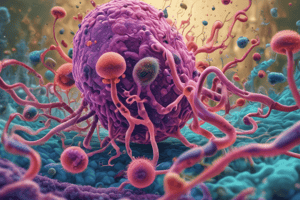Podcast
Questions and Answers
Explain the pathophysiology of cholera and its clinical presentation.
Explain the pathophysiology of cholera and its clinical presentation.
Cholera is caused by the Gram-negative bacterium Vibrio cholerae, which produces a toxin that activates adenylyl cyclase in intestinal epithelial cells of the small intestine, leading to hypersecretion of water and chloride ions and excessive watery diarrhea. The clinical presentation includes rice water diarrhea without odor, blood, or pus, and can result in death from hypovolemia.
Describe the diagnostic approach and treatment for cholera.
Describe the diagnostic approach and treatment for cholera.
Cholera can be diagnosed clinically, and stool cultures can be performed, with a positive result for Vibrio cholerae. Treatment involves fluid and electrolyte replacement, with the addition of salt and sugar. Severe cases may require IV hydration, dexamethasone, and antibiotics such as macrolides, tetracyclines, and fluoroquinolones.
What prevention measures are available for cholera?
What prevention measures are available for cholera?
Preventive measures for cholera include vaccination, which is available to reduce the risk of infection. Additionally, practicing good hygiene and ensuring the consumption of clean, uncontaminated food and water can help prevent cholera infection.
Flashcards are hidden until you start studying




